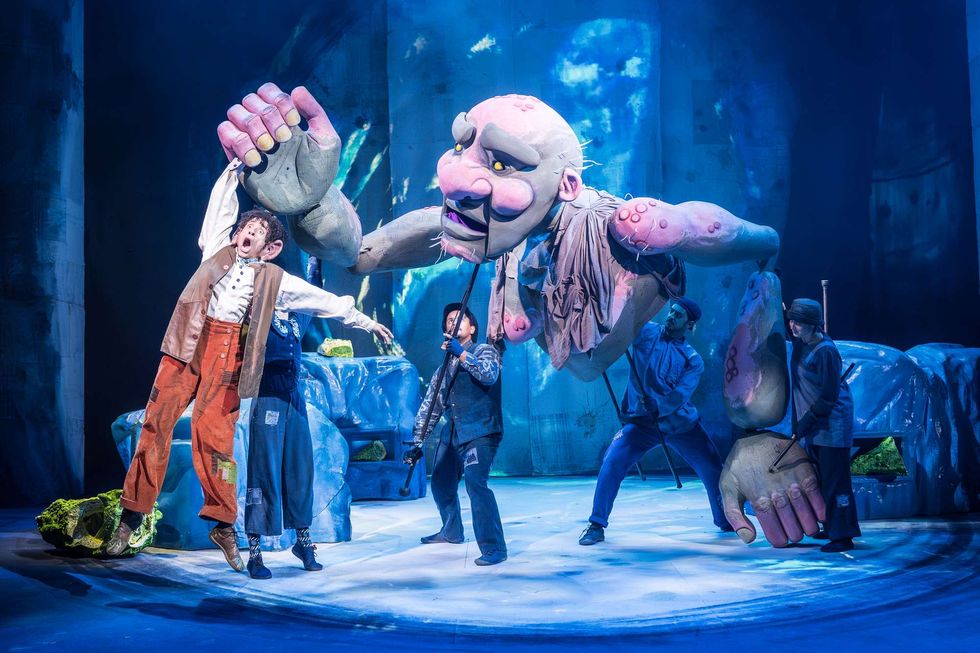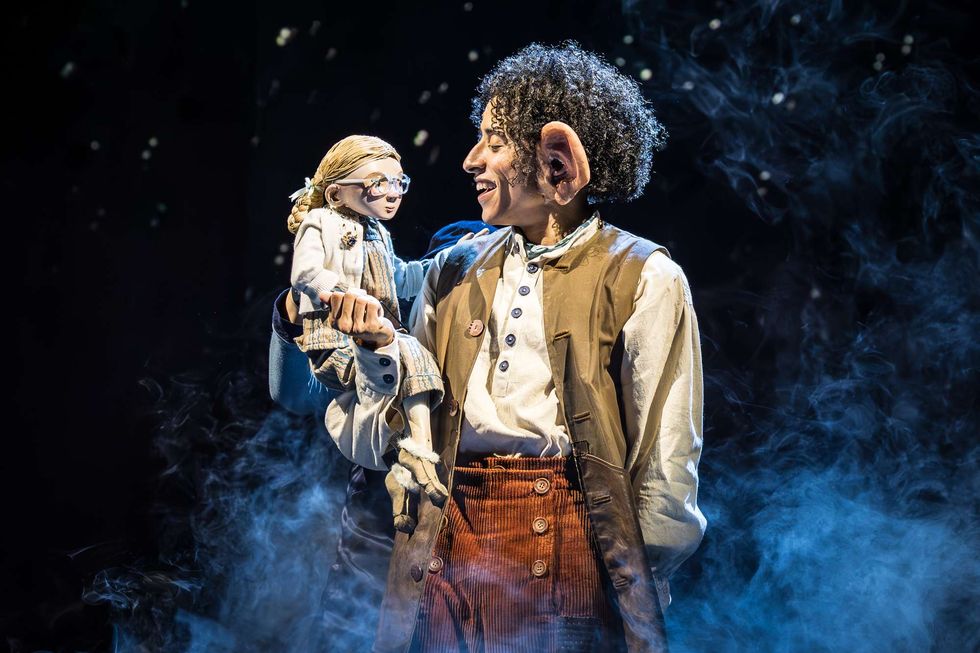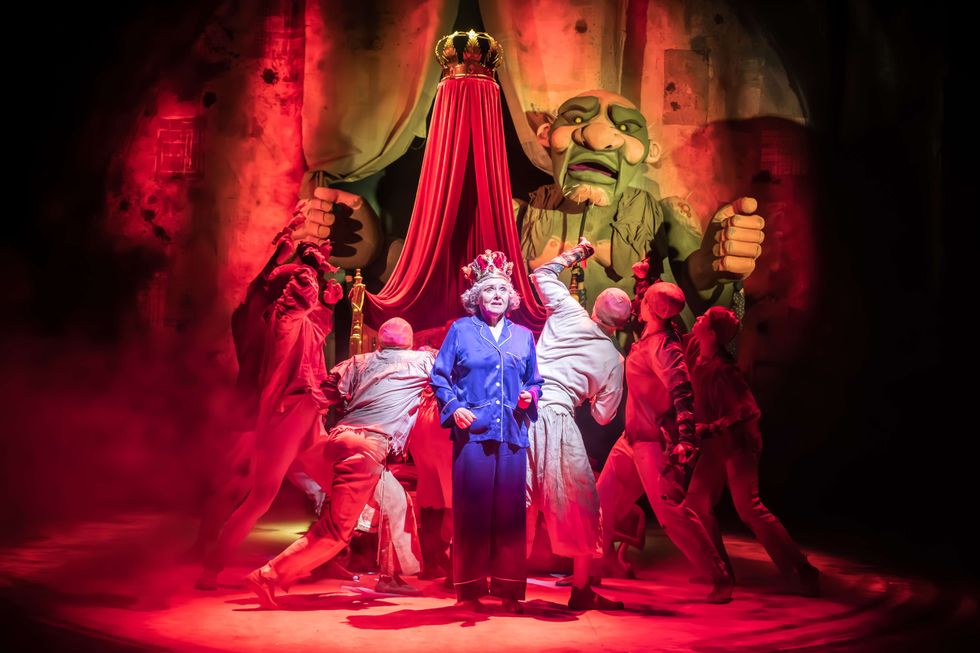REMARKABLE STORY OF THE MUGHAL-E-AZAM MASTERPIECE AND ITS INCREDIBLE LEGACY
by ASJAD NAZIR
THIS week marks the 60th anniversary of Bollywood’s greatest film K Asif’s Mughal-e-Azam, which smashed box office records and set new benchmarks when it released to great fanfare on August 5, 1960.
The K Asif directed epic starring Prithviraj Kapoor, Dilip Kumar and Madhubala commenced a grand voyage that would see it entertain millions across different generations, along with leaving a wonderful legacy that is going strong today. But equally remarkable was the long journey it took to make the movie and all the incredible behind-the-scenes stories.
To celebrate the legendary film turning 60, Eastern Eye decided to present 60 facts about Mughal-e-Azam, its making and legacy.
1. Mughal-e-Azam was the highest budget movie ever made in India, and if inflation along with the colourisation process is taken into account, it still holds on to that record today.
2. It took 16 years in total to get Mughal-e-Azam made. K Asif originally conceptualised the film in 1944, with Chandramohan, Veena and Nargis in the lead roles. An early announcement on Mughal-e-Azam appeared on the cover of the November 1945 issue of the Filmindia magazine.
3. The film was initially supposed to be produced by the legendary Bombay Talkies studio, with iconic 1930s’ actress Devika Rani as a producer.
4. K Asif shot two reels of Mughal-e-Azam with Chandramohan and Nargis, but then Partition in 1947 halted production after the original financiers decided to migrate to Pakistan.
5. All the footage that had been shot went to waste two years later because original lead star Chandramohan died aged 42 in 1949.
6. One of the scriptwriters Kamal Amrohi was also a director and planned to make a film on the same subject, believing Mughal-e-Azam had been cancelled, but agreed to shelve the idea after K Asif confronted him. Amrohi would go on to direct classic courtesan drama Pakeezah (1972), which like Mughal-e-Azam took 16 years to complete.
7. When all hope seemed lost, Shapoorji Pallonji came to the rescue and agreed to finance Mughal-e-Azam. Shapoorji believed in K Asif’s vision even though the cost spiralled out of control.
8. Mughal-e-Azam was based on the theatre play Anarkali, which was first staged in 1922. Unlike previous movies inspired by the play, Mughal-e-Azam has a relatively happy ending with Akbar allowing Anarkali to escape through a secret tunnel, instead of killing her. But his son is still made to suffer, believing she has perished.
9. Young actor Dilip Kumar had newly been discovered by Bombay Talkies in the 1940s and was put forward for the role of Prince Salim, but was originally rejected by K Asif. When production resumed in the early 1950s, Kumar had become the biggest star in Bollywood and was then cast in his career defining role.
10. Superstar actress Suraiya had been considered for the lead role, but it eventually went to Madhubala and became her career-defining character.
11. When the project was revived, Dilip Kumar, Madhubala, Prithviraj Kapoor and Nigar Sultana were cast in the lead roles. Durga Khote was the only lead star, who remained from the original cast. K Asif had worked with Prithviraj Kapoor and Durga Khote in his only other complete movie Phool (1945).
12. Tabla maestro Ustad Zakir Hussain was considered for the role of the young Prince Salim. The role eventually went to Jalal Agha.
13. Bollywood’s first female composer Saraswati Devi originally started work on Mughal-e-Azam in the 1940s, but the original production collapsing meant her songs were lost. By the time Mughal-e-Azam was resurrected in the early 1950s, Naushad had become the number one music director and was given a record-breaking price to compose the songs.
14. A chorus of 100 singers was used for the film’s song Ae Mohabbat Zindabad.
15. The film’s stand-out musical number Pyar Kiya To Darna Kya was inspired by a folk song music director Naushad heard in Uttar Pradesh, with the lyrics ‘Prem kiya, kya chori kari hai...’ Lyricist Shakeel Badayuni rewrote the song some 105 times before it was approved.
16. Singer Bade Ghulam Ali Khan was paid Rs 25,000 for a song in the movie, at a time when top singers like Lata Mangeshkar were getting `400 per number.
17. No expense was spared on the historical epic. Tailors from Delhi stitched the costumes, Hyderabad goldsmiths made the jewellery and Kolhapur craftsmen constructed the crowns. Rajasthani ironsmiths made the shields, swords, spears, daggers and armour. Specialists were employed for the exquisite embroidery on the costumes and the elaborate footwear was ordered from Agra.
18. At the time, major Bollywood movies were filmed in 60-125 shooting days, but opulent epic Mughal-e-Azam needed more than 500 days of filming.
19. Prithviraj Kapoor would prepare himself for each shot by looking at himself in a full-length mirror while in costume.
20. Acting legend Prithviraj was so committed to his character that he walked bare foot in the hot desert for a sequence and got severe blisters. Director K Asif was so overwhelmed that he too removed his shoes during the shooting in the painful desert heat.
21. Dilip Kumar shot his role across six years in total and revealed the demanding heat in the desert wearing heavy armour resulted in him getting blisters all over his body.
22. Real jewels were used throughout the movie, including in a scene where pearls are scattered across the floor and necklaces thrown away. This added to the opulence and authenticity of the epic.
23. More than 2,000 camels, 4,000 horses and 8,000 troops were used in the epic battle between Akbar The Great and Prince Salim.
24. K Asif waited weeks to get large electric poles removed so he could use a particular location to shoot Prince Salim and his army marching.
25. The eye-watering cost of the lavish sheesh mahal set was the same as many films shot during that era and took two years to construct. But the many mirrors meant they couldn’t shoot due to all the reflections, which would capture the cameras and lights. The set sat idle for months and burned more money, until cinematographer RD Mathur figured out a wax coating would lessen the reflective power and they were finally able to shoot key scenes, including the iconic Pyar Kiya To Darna Kya song.
26. Even though the film had gone way over budget, K Asif wanted to reshoot it entirely in colour, but pressure from distributors didn’t allow for this. So pivotal scenes and a song were then stitched in as the only colour sequences in the original black and white release.
27. Despite suffering from a serious heart condition, Madhubala was wrapped in real chains in the scene where she is imprisoned.
28. Madhubala is widely regarded as the most beautiful ever Bollywood star, but Mughal-e-Azam is the only time cinema fans saw her in colour.
29. Legend has it that Madhubala’s father Ataullah Khan was such a menace on the set that director K Asif had to come up with an innovative way to distract him. He gave his assistant money, with strict instructions to lose it while playing cards with gambling enthusiast Khan.
30. Lead stars Dilip Kumar and Madhubala had broken off their relationship half-way through production, so only spoke to each other when scenes where being shot. By the time the classic scene with the feather coming between their lips was shot, they had stopped even greeting each other.
31. Superstar Hollywood director David Lean visited the sets of Mughal-e-Azam. He was so taken by Dilip Kumar that he wanted to cast him in his multi-Oscar winning magnum opus Lawrence of Arabia (1962). Kumar, however, refused the role for which Egyptian actor Omar Sharif would eventually get an Oscar nomination.
32. Royal delegations from Nepal, Afghanistan and Saudi Arabia all came to see the lavish Mughal-e-Azam sets. A cultural delegation from China was also welcomed on set.
33. Legendary Italian filmmaker Roberto Rossellini visited the sets of Mughal-e-Azam, while it was being made.
34. By the time filming concluded, more than a million feet of negative had been used and the excessive running time meant that almost half the songs were edited out from the final cut.
35. The path-breaking film had interesting innovations right from the very beginning, with the opening scene’s narrator being India, instead of a character. A map appears and we hear from India how it has been dissected, looted, loved, chained, unshackled and more.
36. Interestingly, Bollywood is associated with the Hindi language, but the greatest film ever produced by the industry was filmed in Urdu. All Mughal-e-Azam lead stars, Prithviraj Kapoor, Dilip Kumar and Madhubala spoke chaste Urdu throughout. The film’s success led to many Urdu words finding their way into various regional Indian languages.
37. The grand premiere of the movie was held at the 1,100 capacity Maratha Mandir cinema in Mumbai. The foyer was decorated to look like a Mughal palace and a 40-foot cutout of Prithviraj Kapoor was erected outside. The film’s reel arrived at the premiere on an elephant accompanied by giant bugles.
38. The Mughal-e-Azam premiere remains the most star-studded in Bollywood history with nearly every A-list celebrity attending. The superstars who attended included Raj Kapoor, Dev Anand, Waheeda Rehman, Nutan, Suraiya, Geeta Bali, Shammi Kapoor, Guru Dutt, Rajendra Kumar, Raaj Kumar, Meena Kumari, Nimmi and Pran. There were also major politicians, filmmakers and A-list stars from the music industry.
39. A 16-year-old-Saira Banu attended the premiere with her famous mother Naseem Banu. The following year Saira made her Bollywood debut in blockbuster hit Junglee (1961) and then in 1966, the 22-year-old married Mughal-e-Azam lead star Dilip Kumar, who was twice her age.
40. Lead star Dilip Kumar didn’t turn up to the lavish Mughal-e-Azam owing to his cold war with director K Asif. Asif marrying Kumar’s sister and giving Prithviraj Kapoor top billing in the movie triggered the enmity.
41. Even though it was the biggest movie of his career, Dilip Kumar refused to watch the film for almost 19 years.
42. Mughal-e-Azam smashed the record for the highest distribution fee upon release and was sold for four times higher than the usual price per territory for a blockbuster.
43. The day before bookings for the film opened, a reported crowd of over 10,000 gathered outside Maratha Mandir to buy tickets, which were sold for more than 50 times the usual price on the black market.
44. The tickets issued by Maratha Mandir contained pictures and trivia about the film and are today considered collector’s items, exchanging hands for big money.
45. The tickets for Mughal-e-Azam were sold out for seven weeks in advance at Bombay’s Maratha Mandir and the film had an uninterrupted run for three years at the grand cinema.
46. The lavish epic became the highest grossing Bollywood movie of all time when it released in 1960 and held on to the record until Sholay released in 1975. If inflation is taken into account, Mughal-e-Azam is by far the highest box office grosser till date in Indian history.
47. There were plans to release an English dubbed version for international audiences, but they were scrapped despite work commencing on it. A Tamil version had also been filmed.
48. Mughal-e-Azam won a National Award for Best Feature Film and Filmfare Best Film award.
49. Legendary actress Zeenat Aman’s father Amanullah Khan co-wrote Mughal-e-Azam under the pen name Aman. She was born Zeenat Khan, but would use Aman as her surname after entering films.
50. The imposing character played by Prithviraj Kapoor impressed director K Asif so much that he named his son Akbar after him.
51. Mughal-e-Azam became the first full-length feature film colourised for a theatrical re-release, opening in cinemas on November 12, 2004, and becoming a major success. The re-release included a digitally reworked soundtrack produced with the assistance of original composer Naushad.
52. In 2004, Mughal-e-Azam became the first Bollywood film in over 40 years to be officially released in Pakistan. This would subsequently open doors for the rest of the industry to release films in the country.
53. The last major collection by India’s greatest painter MF Husain shortly before his death in 2011, aged 97, was 50 giant canvases inspired by Mughale-Azam. It was full circle for the much-revered painter, who started his career painting cinema hoardings during his early days of struggle.
54. When the hundredth anniversary of Indian cinema was marked in 2013, Mughal-e-Azam was universally declared the greatest Bollywood film ever made.
55. In 2016, an official live musical based on Mughal-e-Azam opened to packed houses and became one of the grandest theatre productions staged anywhere in the world.
56. Late great international acting star Irrfan Khan said his dream role was to portray director K Asif in a biopic about his journey towards getting Mughal-e-Azam made.
57. The historical epic has inspired books, paintings, theme park attractions, dance groups, aspiring filmmakers, actors, stage plays, historical films and even the name of businesses around the world.
58. Acclaimed British singer Susheela Raman did a cover version of Mughal-e-Azam song Mohabbat Ki Jhooti Kahani for the critically acclaimed Indian docu-drama Kajarya (2015), which explored the issue of female infanticide.
59. Mughal-e-Azam still pulls in viewers today and has been made available on major streaming sites. The songs have been watched hundreds of millions of times on video sharing sites like YouTube, with Pyar Kiya To Darna Kya being the most popular and qawwali Teri Mehfil Mein being the second most popular song.
60. Last but not least, Mughal-e-Azam has been receiving universal praise since its release 60 years ago. Words regularly used to describe the epic include, “history making”, “a tribute to the imagination”, “benchmark”, “the greatest Hindi film ever made”, “magnificent” and “perfect”. With more audiences discovering it each year, the film will march on and continue getting the praise it deserves.
Special thanks to Akbar Asif and Deepesh Salgia
‘Perfect entertainer’
MUGHAL-E-AZAM has made many major milestones since it released 60 years ago and one of those is a magnificent stage adaptation that premiered in 2016.
The record-breaking theatre musical successfully captured the magic of K Asif’s 1960 movie masterpiece. One of India’s greatest ever theatre directors, Feroz Abbas Khan took on the impossible task of adapting the movie for stage and stitched himself into the fabric of Mughal-e-Azam forever. The ace director thinks the movie is still admired after 60 years as it’s the closest to a perfect entertainer.
“Mughal-e-Azam is layered with progressive ideas of women empowerment, social justice and religious harmony. You cannot find anything so outstanding in the annals of Indian cinema and very few in world cinema.
K Asif stands very tall globally and will remain so forever,” said Feroz Abbas Khan.
He thinks it’s impossible to choose one aspect of the movie as a favourite and describes it as a work of pure genius. “It is futile to choose any one aspect as a favourite without doing injustice to other aspects of this rare film. An intricate story, perfect screenplay, memorable dialogues, haunting music, exquisite costumes, grand sets, brilliant cinematography and stunning performances.”
The theatre legend was impacted by Mughal-e-Azam thrice. The first was weeping profusely as a teenager at the injustice meted out to the innocent lovers. The second time was rediscovering the magic and its roots in theatre when the colour version released.
The third time was converting the masterpiece into an acceptable theatrical musical play, as his tribute to a timeless epic. “It was audacious and rather ambitious on my part to attempt translating a cult movie into a live theatre experience. Most were certain that this was going to be a disaster and were ready to write my professional obituary. Since this was a musical with live singing, casting became a huge task and that took some time. We were also up against comparisons with the original cast of the film and the precious memories of people who have been living the story, images, speaking the dialogues and singing the songs.”
While it took 16 years to make the movie, Khan had 75 days to complete the theatre production. Although his team successfully achieved it, he jokes the insecurity and frustration of creating the musical still haunts him.
The Mughal-e-Azam stage musical will continue its four-year journey with renewed vigour and passion when the Covid-19 crisis subsides. When asked about his favourite moment from the theatre journey, he said: “In these divisive times, the celebration of our composite culture by three generation of the audience together in applause is overwhelming. For me, when K Asif’s daughter Shabana Asif told me her father would have been proud of the theatre version, I almost wept.”
Khan believes Mughal-e-Azam is a great piece of filmmaking and a precious piece of literature. He thinks it should be included in the educational curriculum. When asked what modern day filmmakers should learn from the movie, he said: “Every aspect of filmmaking can be pushed to its limit and sometimes beyond. The passion, perseverance, perfection and the aspiration to leave behind a work of art for posterity and eternity.”





 The BFG - production images Royal Shakespeare Company/(c) Marc Brenner
The BFG - production images Royal Shakespeare Company/(c) Marc Brenner  BFG production images, directed by Daniel Evans. Royal Shakespeare Theatre, taken in November 2025.Royal Shakespeare Company/(c) Marc Brenner
BFG production images, directed by Daniel Evans. Royal Shakespeare Theatre, taken in November 2025.Royal Shakespeare Company/(c) Marc Brenner BFG production images, directed by Daniel Evans. Royal Shakespeare Theatre, taken in November 2025.Royal Shakespeare Company/(c) Marc Brenner
BFG production images, directed by Daniel Evans. Royal Shakespeare Theatre, taken in November 2025.Royal Shakespeare Company/(c) Marc Brenner





